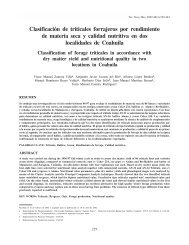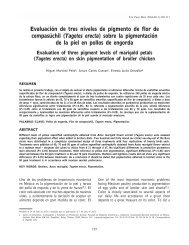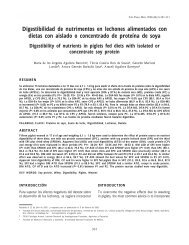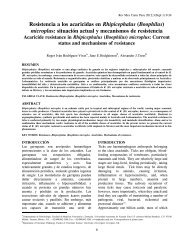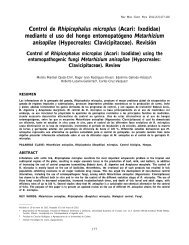Estandarización de la metodología para la determinación de grasa ...
Estandarización de la metodología para la determinación de grasa ...
Estandarización de la metodología para la determinación de grasa ...
Create successful ePaper yourself
Turn your PDF publications into a flip-book with our unique Google optimized e-Paper software.
María Antonia Mariezcurrena Berasain, et al. / Rev Mex Cienc Pecu 2010;1(3):269-275<br />
<strong>de</strong>l 80 % <strong>de</strong> los consumidores seleccionan chuletas<br />
<strong>de</strong> cerdo con niveles menores al 2 % <strong>de</strong> <strong>grasa</strong> (2) .<br />
En el caso <strong>de</strong> los consumidores mexicanos, según<br />
<strong>la</strong> encuesta a amas <strong>de</strong> casa que realizó <strong>la</strong><br />
Confe<strong>de</strong>ración <strong>de</strong> Porcicultores Mexicanos (2008),<br />
más <strong>de</strong>l 50 % consi<strong>de</strong>ra <strong>la</strong> cantidad <strong>de</strong> <strong>grasa</strong><br />
presente en <strong>la</strong> carne antes <strong>de</strong> hacer su selección.<br />
En <strong>la</strong> carne <strong>de</strong> cerdo, <strong>la</strong> <strong>grasa</strong> intramuscu<strong>la</strong>r influye<br />
importantemente en <strong>la</strong>s características sensoriales,<br />
ya que proporciona aroma, sabor y jugosidad (4) .<br />
En el músculo, un incremento <strong>de</strong> hasta el 3.5 %<br />
<strong>de</strong> <strong>grasa</strong> intramuscu<strong>la</strong>r favorece <strong>la</strong> calidad <strong>de</strong> <strong>la</strong><br />
carne (4,5) , lo que representa una oportunidad, ya<br />
que su concentración pue<strong>de</strong> alterarse por medio <strong>de</strong><br />
<strong>la</strong> genética y <strong>la</strong> nutrición (6,7,8) . Esto hace necesario<br />
que se cuente con métodos confiables <strong>para</strong> su<br />
correcta <strong>de</strong>terminación.<br />
Mientras que varios métodos han sido aprobados<br />
por el AOAC <strong>para</strong> <strong>la</strong> <strong>de</strong>terminación <strong>de</strong> <strong>grasa</strong> en<br />
muestras <strong>de</strong> carne, nuevos sistemas <strong>de</strong> extracción<br />
tipo Soxhlet ofrecen diferentes alternativas<br />
(diferentes solventes, tamaños <strong>de</strong> muestra y tiempos<br />
<strong>de</strong> extracción), lo cual hace necesaria <strong>la</strong> com<strong>para</strong>ción<br />
entre <strong>la</strong>s distintas <strong>metodología</strong>s.<br />
El presente trabajo, tuvo como objetivo <strong>de</strong>finir y<br />
estandarizar <strong>la</strong> <strong>metodología</strong> más eficiente (cantidad<br />
<strong>de</strong> <strong>grasa</strong> extraída) y eficaz (repetitividad) <strong>para</strong><br />
<strong>de</strong>terminar <strong>la</strong> concentración <strong>de</strong> <strong>grasa</strong> en muestras<br />
<strong>de</strong> carne <strong>de</strong> cerdo. El método que se utilizó <strong>para</strong><br />
<strong>la</strong> extracción <strong>de</strong> <strong>grasa</strong> en <strong>la</strong> carne, es una<br />
modificación <strong>de</strong>l recomendado por el fabricante<br />
<strong>de</strong>l equipo <strong>de</strong> extracción Soxtec Foss Tecator 2055,<br />
el cual está basado en el método gravimétrico<br />
establecido por <strong>la</strong> AOAC (9) y permite el análisis <strong>de</strong><br />
seis muestras a <strong>la</strong> vez.<br />
Para realizar <strong>la</strong> extracción, <strong>la</strong> muestra <strong>de</strong> carne<br />
previamente secada a peso constante (24 h a 65<br />
°C), se mezc<strong>la</strong> con 5 g <strong>de</strong> arena y se coloca en un<br />
<strong>de</strong>dal <strong>de</strong> cartón previamente secado. Luego inicia<br />
el proceso que se realiza en cuatro fases. La primera<br />
se <strong>de</strong>nomina ebullición y en ésta el <strong>de</strong>dal junto con<br />
<strong>la</strong> muestra están sumergidos en el solvente, en <strong>la</strong><br />
segunda fase el <strong>de</strong>dal y <strong>la</strong> muestra son enjuagados<br />
constantemente por el solvente que se con<strong>de</strong>nsa y<br />
270<br />
Producer Confe<strong>de</strong>ration in 2008 showed that more<br />
than 50 % housewives take fat content into account<br />
at the time of meat selection. Intramuscu<strong>la</strong>r pork<br />
fat has a strong impact on sensorial traits, because<br />
it provi<strong>de</strong>s meat with aroma, taste, and juiciness (4) .<br />
An increase of up to 3.5 % intramuscu<strong>la</strong>r fat<br />
enhances pork quality (4,5) . This poses an<br />
opportunity, since fat content can be altered by<br />
genetic or nutritional means (6,7,8) . Therefore,<br />
reliable methods are nee<strong>de</strong>d for proper fat<br />
<strong>de</strong>termination.<br />
The Association of Official Agricultural Chemists<br />
(AOAC) has approved several methods for the<br />
<strong>de</strong>termination of fat in meat samples. Nevertheless,<br />
new fat extraction systems (i.e., the Soxhlet) offer<br />
different alternatives (different solvents, samples<br />
sizes, and extraction times). Therefore, a comparison<br />
of the different methodologies is nee<strong>de</strong>d.<br />
The purpose of this study was to <strong>de</strong>fine and<br />
standardize the most efficient (amount of fat<br />
extracted) and efficacious (repetitiveness)<br />
methodologies to <strong>de</strong>termine fat concentrations in<br />
pork samples. The method used to extract pork fat<br />
is a modification of that recommen<strong>de</strong>d by the Soxtec<br />
Foss Tecator 2055 extraction equipment<br />
manufacturer, which is based on a gravimetric<br />
method established by the AOAC (9) , it allows for<br />
analyzing six samples at a time.<br />
In or<strong>de</strong>r to perform the extraction, a meat sample<br />
is previously dried down to a constant weight<br />
(24 h at 65 °C), then mixed with 5 g of sand and<br />
p<strong>la</strong>ced in a pre-dried paper thimble. The extraction<br />
process that inclu<strong>de</strong>s four phases is started.<br />
Phase 1 (varies between 20 to 75 min), is called<br />
the boiling phase. Both thimble and samples are<br />
immersed in a solvent. In Phase 2 (30 min), both<br />
sample and thimble are subjected to a constant<br />
solvent rinse, which is con<strong>de</strong>nsed and drained<br />
through the sample. During Phase 3 (10 min) the<br />
solvent is recovered. Finally, the sample is dried in<br />
Phase 4 (10 min).<br />
Our study evaluated the variables that are most<br />
frequently modified during a meat fat analysis, i.e.,<br />
the effect of thre different solvent types: petroleum



